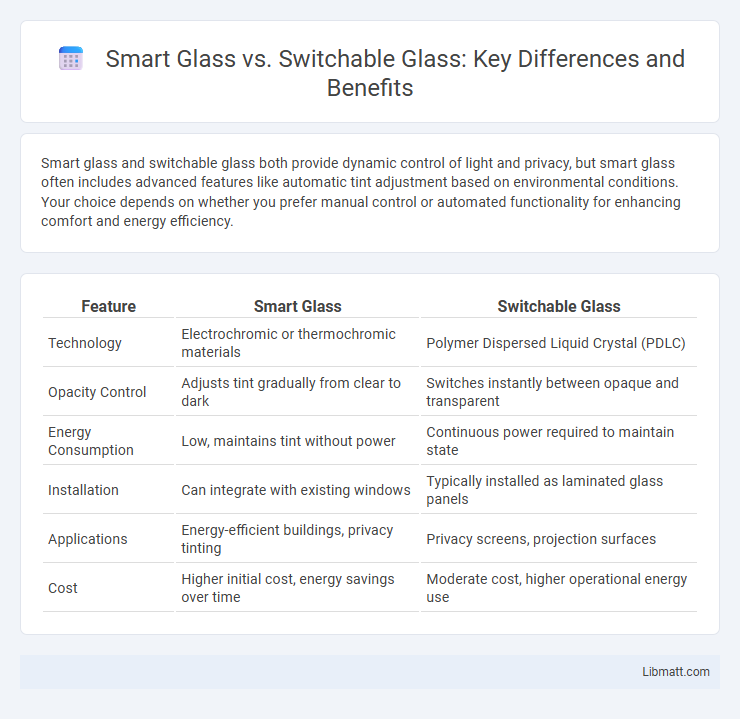Smart glass and switchable glass both provide dynamic control of light and privacy, but smart glass often includes advanced features like automatic tint adjustment based on environmental conditions. Your choice depends on whether you prefer manual control or automated functionality for enhancing comfort and energy efficiency.
Table of Comparison
| Feature | Smart Glass | Switchable Glass |
|---|---|---|
| Technology | Electrochromic or thermochromic materials | Polymer Dispersed Liquid Crystal (PDLC) |
| Opacity Control | Adjusts tint gradually from clear to dark | Switches instantly between opaque and transparent |
| Energy Consumption | Low, maintains tint without power | Continuous power required to maintain state |
| Installation | Can integrate with existing windows | Typically installed as laminated glass panels |
| Applications | Energy-efficient buildings, privacy tinting | Privacy screens, projection surfaces |
| Cost | Higher initial cost, energy savings over time | Moderate cost, higher operational energy use |
Introduction to Smart Glass and Switchable Glass
Smart glass, also known as switchable glass, is an advanced glazing technology that dynamically changes its light transmission properties based on electrical, thermal, or light stimuli. This innovative material enhances energy efficiency, privacy, and comfort by allowing you to control the opacity and transparency of windows or partitions. Smart glass and switchable glass essentially refer to the same product, offering versatile solutions for residential, commercial, and automotive applications.
How Smart Glass Works
Smart glass operates by altering its light transmission properties using technologies like electrochromic, thermochromic, or suspended particle devices, which respond to electrical signals, temperature, or light. Switchable glass, a type of smart glass, uses an internal film of liquid crystals or polymer-dispersed liquid crystals that change opacity when an electrical current is applied, instantly shifting from transparent to opaque. Your choice between these technologies depends on factors such as control method, energy efficiency, and the desired level of privacy or sunlight regulation.
How Switchable Glass Works
Switchable glass operates by applying an electric current to a transparent conductor layer infused with liquid crystals or suspended particles, enabling it to change from opaque to transparent instantly. This technology, also known as electrochromic or PDLC (Polymer Dispersed Liquid Crystal) glass, actively controls light transmission and privacy without requiring mechanical blinds or curtains. The ability to modulate transparency on demand improves energy efficiency, enhances comfort, and offers innovative architectural solutions compared to traditional smart glass options.
Key Differences Between Smart Glass and Switchable Glass
Smart glass and switchable glass differ primarily in technology and functionality: smart glass utilizes electrochromic, thermochromic, or photochromic properties to change transparency automatically, while switchable glass relies on liquid crystal or suspended particle devices activated by an electric current to toggle between opaque and transparent states. Smart glass offers gradual light control and energy efficiency by responding to environmental conditions, whereas switchable glass provides instant, user-controlled privacy and shading. Your choice depends on whether you prioritize automated energy savings or immediate privacy adjustment.
Applications in Residential Settings
Smart glass and switchable glass enhance residential settings by offering customizable privacy and light control, ideal for windows, skylights, and interior partitions. Switchable glass uses electrochromic or polymer-dispersed liquid crystal technology to transition from transparent to opaque, providing instant privacy without curtains or blinds. Your home benefits from energy efficiency, UV protection, and modern aesthetics, making these solutions perfect for bedrooms, bathrooms, and living areas.
Commercial Uses: Smart Glass vs Switchable Glass
Smart glass enhances energy efficiency, privacy, and light control in commercial buildings by automatically adjusting transparency based on environmental conditions. Switchable glass, ideal for conference rooms and healthcare facilities, provides instant privacy on demand through electrical activation, optimizing space flexibility and confidentiality. Your choice between smart glass and switchable glass depends on the desired balance between automated light management and user-controlled opacity for specific commercial applications.
Energy Efficiency Comparison
Smart glass and switchable glass both enhance energy efficiency by controlling solar heat gain and natural light transmission, significantly reducing the need for artificial lighting and climate control. Switchable glass, often using electrochromic technology, offers dynamic tinting that adapts to changing sunlight conditions, providing superior thermal regulation compared to static smart glass coatings. This adaptive capability results in optimized HVAC performance and substantial energy savings in commercial and residential buildings.
Cost and Installation Factors
Smart glass typically costs more upfront due to advanced technology and requires professional installation to ensure proper wiring and integration. Switchable glass, while slightly higher in price than traditional glass, may involve additional expenses for automation controls but can offer easier retrofitting in existing structures. Your choice should consider both budget constraints and the complexity of installation, as these factors significantly impact the overall investment.
Longevity and Maintenance
Smart glass generally offers greater longevity and lower maintenance due to its durable electrochromic or PDLC materials that resist wear and tear over time. Switchable glass may require more frequent servicing or replacement of electrical components such as films and controllers, which can degrade with prolonged use. Proper installation and environmental conditions also significantly influence the lifespan and upkeep requirements of both smart and switchable glass technologies.
Which Glass Technology Is Right for You?
Smart glass offers dynamic control of light and privacy through electronic tinting technology, ideal for energy efficiency and modern aesthetics in residential or commercial spaces. Switchable glass utilizes liquid crystal or polymer dispersed technology to toggle between transparent and opaque states, providing instant privacy and glare reduction, perfect for conference rooms or healthcare environments. Choosing between smart glass and switchable glass depends on your specific needs for light control, privacy, energy savings, and application type.
smart glass vs switchable glass Infographic

 libmatt.com
libmatt.com